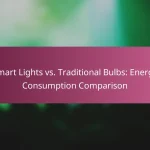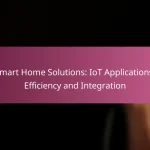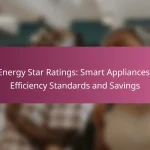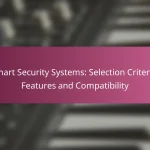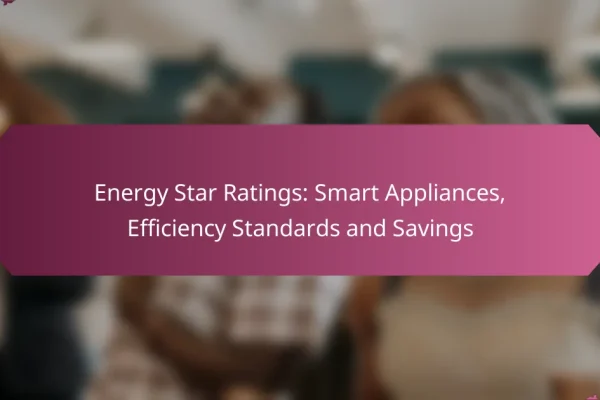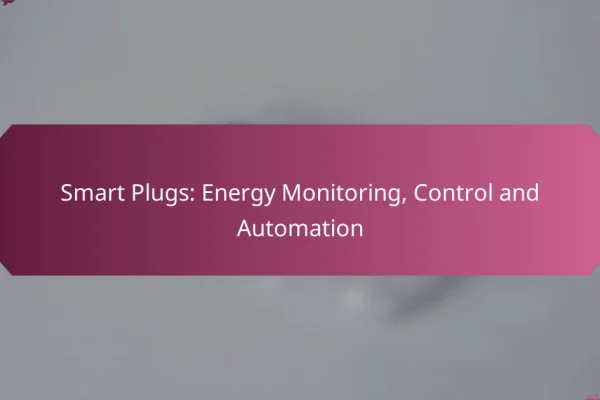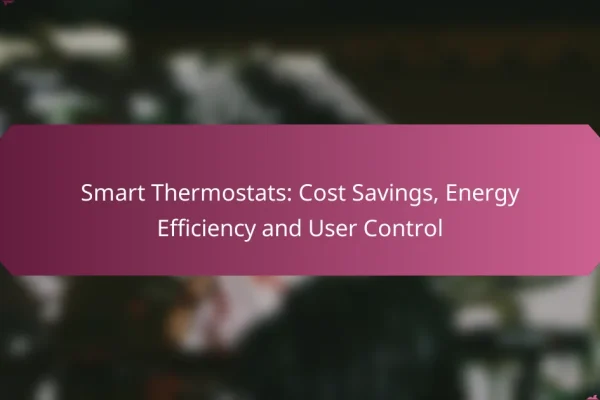How do smart home devices improve energy efficiency?
Smart home devices enhance energy efficiency by automating and optimizing energy use in households. These technologies help reduce waste, lower utility bills, and contribute to a more sustainable lifestyle.
Smart thermostats reduce heating and cooling costs
Smart thermostats automatically adjust the temperature based on your schedule and preferences, significantly cutting heating and cooling expenses. They learn your habits over time, allowing for more precise control of your home’s climate.
For example, a smart thermostat can lower the temperature when you’re away and raise it before you return, ensuring comfort without unnecessary energy use. Many models can save homeowners around 10-15% on their heating and cooling bills annually.
Smart lighting systems optimize energy use
Smart lighting systems allow for remote control and automation of lights, which can lead to substantial energy savings. By using motion sensors and timers, these systems ensure that lights are only on when needed.
For instance, you can set your lights to turn off automatically when you leave a room or adjust brightness based on natural light levels. This can reduce energy consumption by up to 30% compared to traditional lighting solutions.
Smart plugs monitor and control energy consumption
Smart plugs enable you to monitor and control the energy usage of individual devices. By connecting appliances to smart plugs, you can track their energy consumption and set schedules to turn them off when not in use.
For example, you can program a smart plug to turn off your coffee maker after a certain period, preventing energy waste. Some smart plugs also provide insights into energy usage patterns, helping you identify which devices consume the most power.
What are the best smart home devices for energy savings?
The best smart home devices for energy savings include programmable thermostats, smart lighting, and energy monitoring plugs. These devices help optimize energy consumption, reduce waste, and can lead to significant savings on utility bills.
Nest Learning Thermostat
The Nest Learning Thermostat is designed to learn your heating and cooling preferences over time, automatically adjusting the temperature to maximize energy efficiency. It can save users around 10-12% on heating and 15% on cooling bills, making it a worthwhile investment.
To get the most out of the Nest, ensure it is installed in a central location and connected to Wi-Fi for remote access. Regularly check the app for energy reports and adjust settings based on your schedule to enhance savings.
Philips Hue Smart Bulbs
Philips Hue Smart Bulbs allow you to control lighting remotely and set schedules, which can significantly reduce energy use. By switching to LED technology, these bulbs consume up to 80% less energy than traditional incandescent bulbs.
Consider using the app to create routines that turn lights off when not in use or dim them during the day. This can lead to noticeable reductions in your electricity bill over time.
TP-Link Kasa Smart Plug
The TP-Link Kasa Smart Plug enables you to control devices remotely and schedule their operation, helping to eliminate energy waste from electronics left on unnecessarily. This plug can monitor energy usage, providing insights into which devices consume the most power.
To maximize savings, plug in high-energy devices like heaters or fans and set timers to operate only when needed. Regularly review the energy usage data to identify and adjust habits for better efficiency.
How to choose energy-efficient smart home devices?
To choose energy-efficient smart home devices, prioritize products that reduce energy consumption while meeting your needs. Look for features that enhance efficiency, such as automation and remote control capabilities, which can help lower utility bills.
Look for ENERGY STAR certification
Devices with ENERGY STAR certification meet strict energy efficiency guidelines set by the U.S. Environmental Protection Agency. These products typically use 10-50% less energy than standard models, making them a smart choice for reducing energy costs.
When shopping, check for the ENERGY STAR label on appliances like smart thermostats, lighting, and smart plugs. This certification not only indicates energy savings but also often comes with rebates or incentives from local utility companies.
Consider compatibility with existing systems
Before purchasing smart home devices, ensure they are compatible with your current systems, such as Wi-Fi networks or smart home hubs. Compatibility can significantly enhance energy efficiency by allowing devices to communicate and work together seamlessly.
For example, a smart thermostat that integrates with your HVAC system can optimize heating and cooling schedules based on your usage patterns. Always review product specifications and user reviews to confirm compatibility before making a decision.
What are the costs associated with smart home energy solutions?
The costs of smart home energy solutions typically include the initial investment for devices and the potential savings on energy bills. Understanding these costs helps homeowners make informed decisions about integrating smart technology into their homes.
Initial investment for devices
The initial investment for smart home devices can vary significantly based on the type and brand of technology. Basic smart thermostats may start around $100, while comprehensive systems that include smart lighting, security cameras, and energy monitors can range from several hundred to over a thousand dollars.
When considering the initial investment, it’s essential to evaluate the long-term benefits and potential return on investment. Look for devices that offer compatibility with existing systems and check for any available rebates or incentives from local energy providers that can offset costs.
Potential savings on energy bills
Smart home devices can lead to substantial savings on energy bills, often in the range of 10-30% depending on usage patterns and the types of devices installed. For example, smart thermostats can optimize heating and cooling schedules, resulting in lower energy consumption.
To maximize savings, homeowners should monitor their energy usage through smart devices and adjust settings accordingly. Additionally, consider using energy-efficient appliances and integrating them with smart technology to further enhance energy savings and reduce overall costs.
How do smart home devices integrate with renewable energy sources?
Smart home devices can effectively integrate with renewable energy sources, primarily by optimizing energy consumption and enhancing the use of generated energy. This integration allows homeowners to manage their energy use more efficiently, reducing reliance on traditional power grids.
Compatibility with solar panel systems
Many smart home devices are designed to work seamlessly with solar panel systems, allowing users to monitor energy production and consumption in real-time. For instance, smart inverters can connect to home networks, providing data on solar energy generation and usage patterns.
When selecting smart devices, ensure they are compatible with your solar setup. Look for products that support common communication protocols like Wi-Fi or Zigbee, which facilitate integration with solar monitoring systems.
Energy management through smart devices
Smart devices enhance energy management by automating and optimizing energy use based on real-time data. For example, smart thermostats can adjust heating and cooling based on energy availability from solar panels, ensuring that energy is used when it’s most abundant.
To maximize energy efficiency, consider using smart plugs and energy monitors that help track energy consumption of individual appliances. This can help identify high-energy devices and encourage usage during peak solar production times, ultimately lowering energy bills and increasing sustainability.
What are the future trends in smart home energy efficiency?
Future trends in smart home energy efficiency focus on advanced technologies that optimize energy consumption and enhance user control. Innovations like AI integration, improved home automation systems, and renewable energy management are set to transform how households manage their energy use.
Increased AI integration for energy management
AI integration in smart home devices allows for more sophisticated energy management by analyzing usage patterns and optimizing settings accordingly. For example, smart thermostats can learn your schedule and adjust heating or cooling to minimize energy waste while maintaining comfort.
Homeowners can expect AI-driven systems to provide real-time feedback on energy consumption, suggesting actionable changes to reduce costs. These systems can also communicate with other smart devices, creating a cohesive energy management strategy that can adapt to changing conditions.
When considering AI integration, look for devices that offer compatibility with existing smart home ecosystems. Prioritize products that provide user-friendly interfaces and clear data analytics to help you make informed decisions about your energy use.

